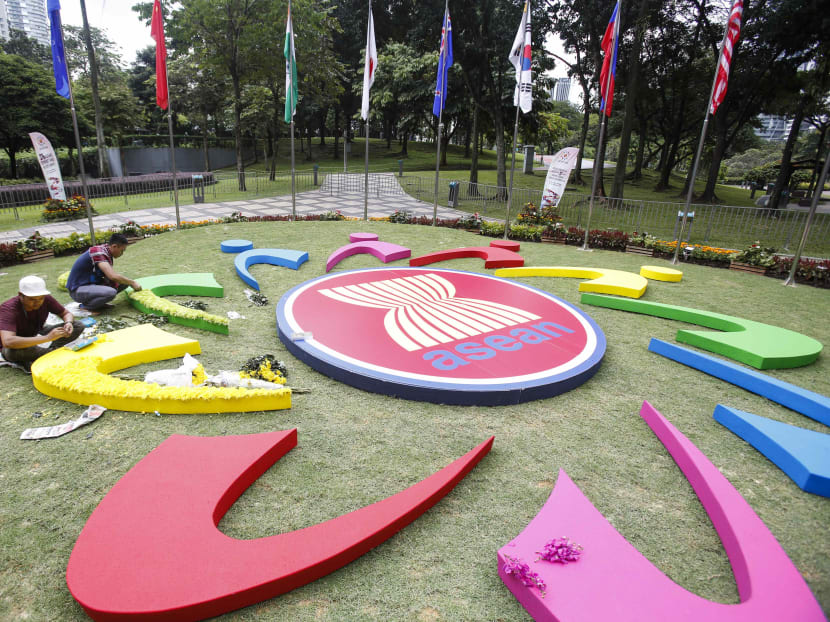Time for Asean’s own brand product in manufacturing?
There is no reason for the Association of South-east Asian Nations (Asean) not to have its own variant of Sony or Samsung. Perhaps it is about time now for Asean to step up its economic integration strategy and create its own brand of products.

The electronics sector offers potential for Asean to launch its own brand products, says the author. Photo: AP
There is no reason for the Association of South-east Asian Nations (Asean) not to have its own variant of Sony or Samsung. Perhaps it is about time now for Asean to step up its economic integration strategy and create its own brand of products.
Afterall, the grouping is now the world’s sixth largest economy. Its total trade amounted to US$2.3 trillion (S$3.12 trillion) in 2015. Among the grouping’s policies include attracting investments from multinational companies outside the region, which is justifiable because Asean is predicted to be the world’s factory over the next 10 to 15 years.
It is also important for Asean to realise the potential of regional production in creating its own brand products, which will involve the participation of all countries in the region.
ASEAN’S OWN BRAND IN THE ELECTRONICS SECTOR
There are several factors why the electronics sector offers potential for Asean to launch its own brand products.
First, electronics is the largest export sector in the region, which amounted to more than US$289 billion in 2015 or equivalent to 25 per cent of total Asean exports in goods.
According to the Asean Secretariat, electrical-related products also represent 21.4 per cent and 26.3 per cent of total intra-Asean and extra-Asean export commodity items, respectively.
Moreover, what is more interesting in Asean is the potential distribution of factors of production among its member countries, which could be realised over the next 15 years.
How is it possible to develop an ‘Asean brand’ product in the electronics sector?
Over the next 10 to 15 years, Asean is projected to experience the formation of three sub-regions, namely, the Mekong Frontier (Myanmar, Cambodia, Laos), the Mid-Manufacturing Competitors (Thailand, Vietnam, Indonesia, the Philippines), and the High-Income Economies (Singapore, Malaysia), according to a study by Australia and New Zealand Banking Group Limited titled “ASEAN: The Next Horizon”.
The Mekong Frontier will provide cheap labour to the production platforms in the Mid-Manufacturing Competitors, which is the most cost-effective mid-value manufacturer in the region, while the High Income Economies will provide the development of high value-added activities such as product designs.
In other words, the combination of economic strengths of each Asean member state will provide the preconditions for South-east Asia to develop its own brand products in the electronics sector.
Singapore in particular, is poised to provide value-added activities as part of the High Income Economies sub-region. The Economic Development Board said that Singapore has a strong R&D culture for developing new components and products, which ranges from component-level design to system level product design as well as industrial design.
Interestingly, Singapore has also publicly funded centres like the university research centres that push the boundaries of technology through research.
Meanwhile, Malaysia is continuously strengthening its semiconductors, solar, and light-emitting diode industries. However, the country needs further investments in human capital development to have an adequate pool of skilled talent for high value-added activities, according to a study by the International Labour Organisation (ILO).
On the other hand, the countries in the Mid-Manufacturing Competitors sub-region could become the production platforms for producing ‘white goods’ (household appliances) and ‘3C’ electronics (computer, consumer, communications).
For example, the Philippines is a significant player in the manufacturing of electronic data processing equipment, which include desktop PCs, printers, and laptops. Thailand, on the other hand, is recognised as the world second’s largest manufacturer of air conditioning units, according to ILO’s study.
It is also interesting to know that 50 per cent of Samsung mobile phones are manufactured in Vietnam, while Indonesia’s electronics industry in Batam is known for its consumer electronic products.
The products manufactured in these countries will increasingly become more sophisticated through value-added activities in Singapore and Malaysia. Meanwhile, the countries in the Mekong Frontier will provide low cost of labour in the production process.
TOWARDS STRONGER REGIONAL INTEGRATION
The creation of ‘Asean brand’ products will strengthen economic integration in the region. It will also become an opportunity to leverage the diverse economic landscape of the region. But in order for this to work, there needs to be investment in human capital that will provide the labour force with necessary skills.
It is also important to have a framework that is designed to identify what production activities should be enhanced in the region.
Production synergy will also help Asean reinforce its centrality in the regional economic architecture by aligning the countries’ objectives to create ‘Asean brand’ products.
This will also help the region to become a deeply integrated and cohesive regional economy. Interestingly, it will also contribute for the achievement of inclusive growth because the production process necessitates both human resource development and innovation, which foster productivity growth across the region.
This year is the 50th anniversary of Asean. With the growing economic prospects of Asean, it may be time to further build up a strategy for economic integration where all member countries will cooperate towards developing the region’s own brand of products.
ABOUT THE AUTHOR
Phidel Vineles is a Senior Analyst at the Centre for Multilateralism Studies (CMS) at the S. Rajaratnam School of International Studies (RSIS), Nanyang Technological University in Singapore. The views expressed in this article are those of the author, and do not reflect the position and opinions of RSIS.






